The Microsoft Surface Studio Review
by Brett Howse on January 20, 2017 8:00 AM EST- Posted in
- Desktop
- Microsoft
- Surface
- Surface Studio
Color Modes: sRGB, DCI-P3, and Vivid
Next up, let’s take a look at the color gamut accuracy on the three different display modes. sRGB is the one that most people are going to want to use most of the time, because most applications do not have any color management, but in the images below you can see just how much larger the P3 gamut is. It appears P3 is making its way to being the next gamut for computers, but without color management, it is going to be a messy transition.
sRGB
sRGB is still the default target for almost everything, so it is important to get this one right, even more than the others. You can see that the Surface Studio easily covers the sRGB gamut, and it is almost perfect at doing it. Really only the white levels bring the error levels up, with the colors almost perfect for this gamut.
DCI-P3
The sRGB gamut coverage was good, but the DCI-P3 is even better, with a much more accurate white point for this color space really helping the average error level here. But take a good look at the actual white point in the image, which is the square inside the triangle. On this color space, the white point shifts much higher into green, and away from the pure white you would expect of sunlight, which we call D65. The DCI-P3 gamut does not use D65, and is therefore not really going to be used much on the Surface Studio.
Vivid
Although called Vivid, this color mode is the correct P3 color space for computers, which is P3 D65. The gamut coverage is the same as DCI-P3, but the white point moves to the D65 point which is sunlight at noon. The Surface Studio is somehow even more accurate hitting this gamut than the two that are correctly named. Using the name Vivid is a poor choice in naming this when the other two color spaces are named correctly, so if you do own or buy a Studio, and you do want to look at P3 gamut content, Vivid is the correct color space to choose for this.
Color Accuracy
Now that we’ve looked at the various color spaces, it’s time to examine each one individually to see how the Surface Studio performs when set to each color space.
sRGB
On the sRGB tests, the grayscale and saturation tests were done to the new 2017 standard of 4-bit steps rather than 5% and 20% steps respectively. This gives a better picture of what the display is doing, and a much more accurate gamma result.
Grayscale
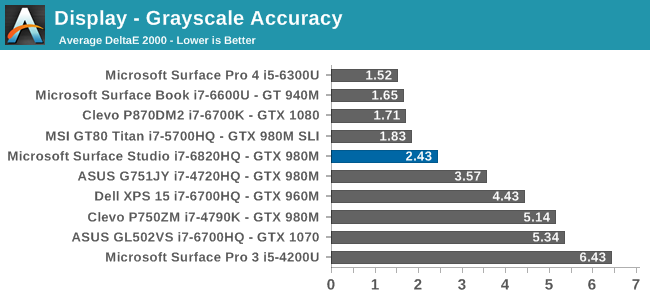
Microsoft nailed the gamma, which should be 2.2, and it very nearly is. However some errors creep up in the grayscale as the image gets closer to 100% white, with the red levels too high, and green a bit low. Overall, it’s still a very good average result, but not perfect. Notice how far they have come since the Surface Pro 3.
Saturation
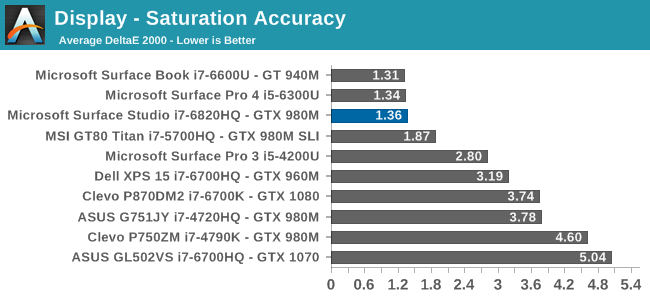
Once again, other than the white level errors at 100% white, the saturation result is fantastic. An overall error level of just 1.36 is very strong, and the individual color traces show that there are no real issues with any of the primary or secondary colors when set to sRGB.
Gretag Macbeth
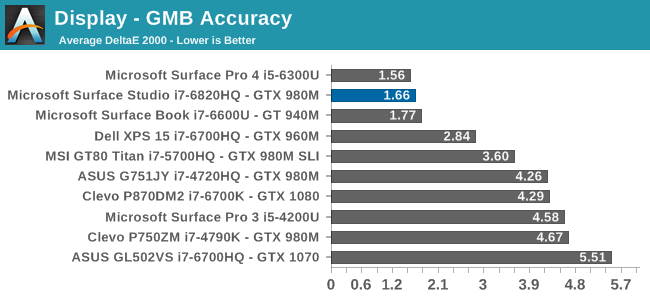
This test is the most comprehensive test, covering a large number of color points, including the important flesh tones. Here, again, the Surface Studio ends up with a fantastic result, and other than a single color, most of the errors are less than two, with many much closer to one. The sRGB results have started off very strong.
DCI-P3
Grayscale
When testing for the DCI-P3 color space, the gamma changes to 2.4, and the Surface Studio correctly hits this gamma as well. Across the entire grayscale sweep, the red, blue, and green levels are very consistent, and the average error level is just 1.27, which is outstanding. The display hits this new gamma and white point almost perfectly.
Saturation
Continuing its impressive results, the Surface Studio is practically perfect on the DCI-P3 saturation sweeps. The blue results and 100% white are the only real issues, but neither of them are really much of an issue at all.
Gretag Macbeth
An average error level under one is a great result again, and although there are a few individual colors that jump up to dE 2000 of three or so, almost every color tested is well under one.
Vivid (P3 D65)
Grayscale
The P3 D65 gamut moves back to a gamma of 2.2, and the Surface Studio nicely hits that. The error levels on the grays are all very low, with only 97.3% white jumping over the two line. The D65 white point is also almost perfect, with the red just a bit higher than it should be, but not to a level that would be very noticeable.
Saturation
The saturation graph is amazingly accurate. Only 20% yellow even crosses the one mark, outside of white and black.
Gretag Macbeth
Finally, the Gretag Macbeth test continues the trend of fantastic display calibration on the Surface Studio. Just a single color tested has an error level over three, with pretty much the rest of the tested colors showing an error level of under one. It is a pretty fantastic result.
Display Conclusions
It’s difficult to not be impressed by the work put into the Surface Studio’s display. Here we have a display with an ICC profile for sRGB, DCI-P3, and P3 D65, and in every gamut, the accuracy levels are near, if not the best, that have ever been tested on this site. It is a fantastic achievement, and a testament to what can happen if a company decides to focus on quality. There is no doubt that the Surface Studio’s display is the stand-out feature on this PC, and Microsoft has taken the time to individually calibrate each display to one of the highest levels of accuracy possible.
The fact that this display also features ten-point multitouch, and pen support, as well as having accuracy that is top-notch, makes the Surface Studio arguably the best computer display targeted towards consumers and prosumers. Combine that with the excellent 3:2 aspect ratio, the high pixel density, and practically perfect display scaling, and it would be hard to find any faults with this display. It truly is a masterpiece.


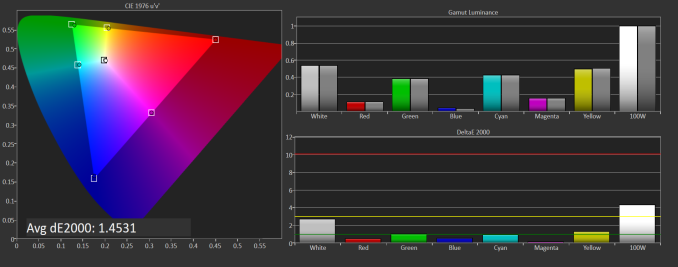
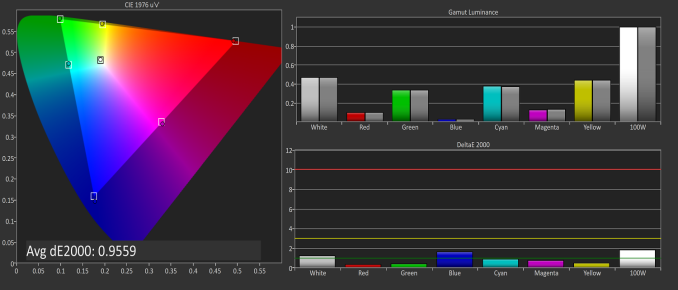

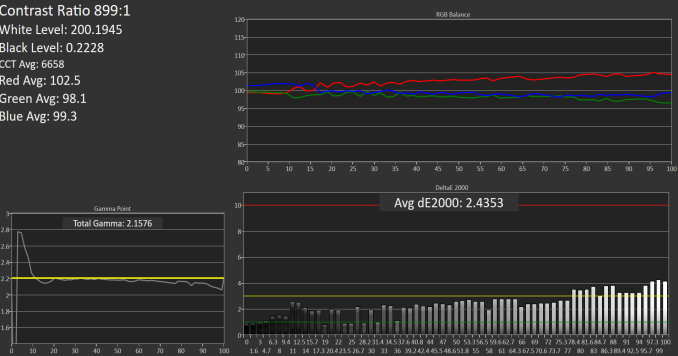
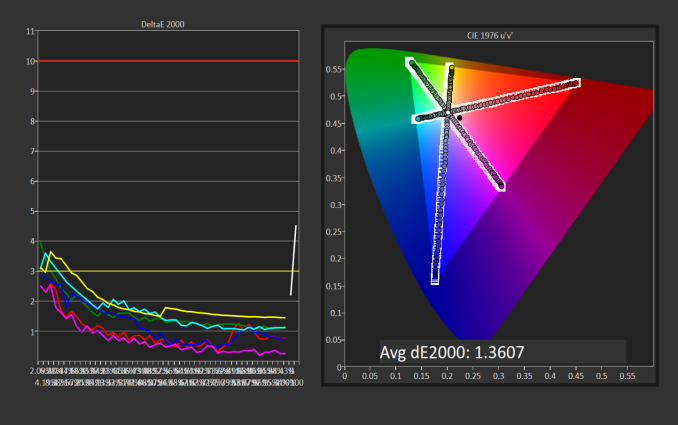

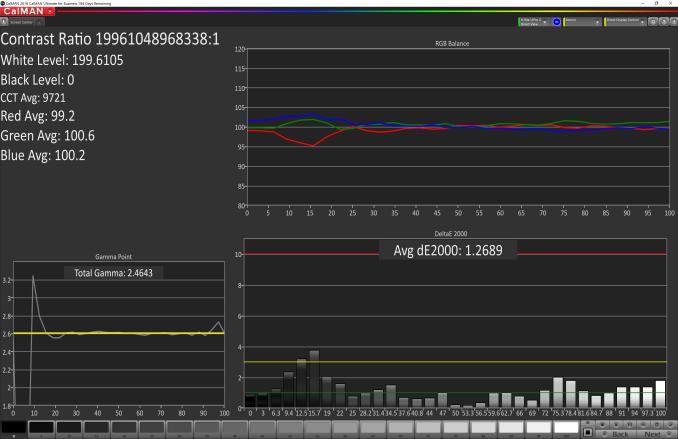
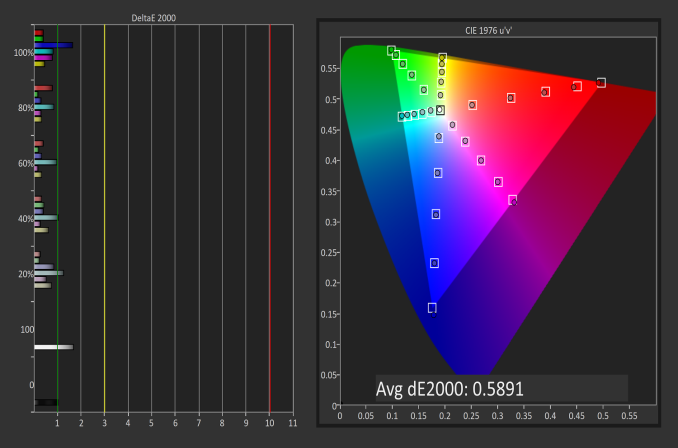
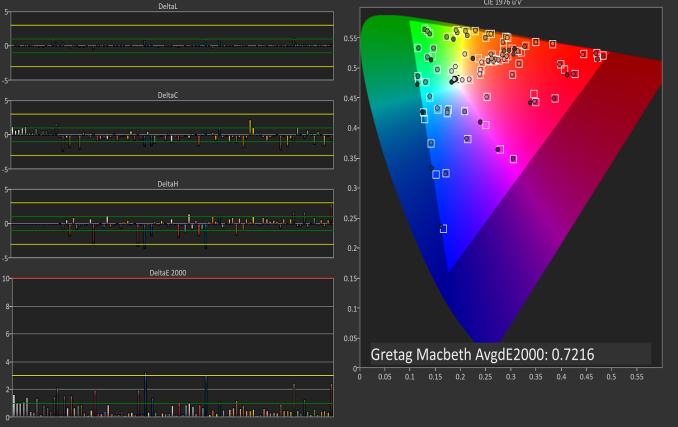

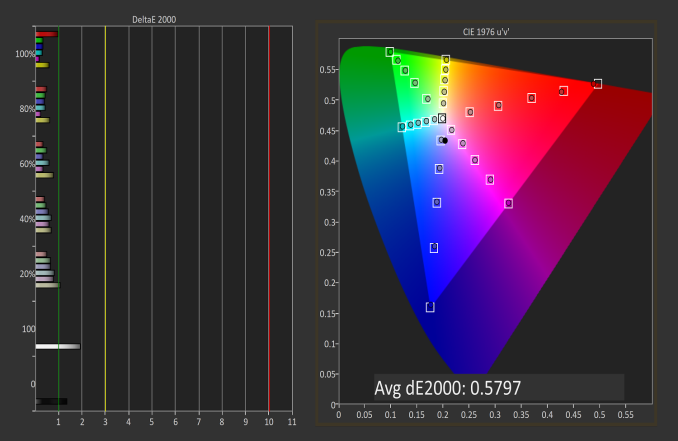
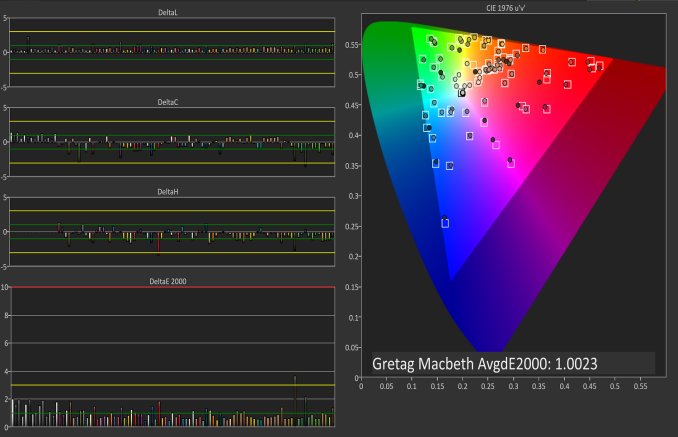








197 Comments
View All Comments
Devo2007 - Friday, January 20, 2017 - link
With all the bugs of the Surface Pro 4 tablet and Surface Book, I wouldn't call either of them among the best. As for the Surface Studio, it is aimed at such a niche audience that it will probably be quite some time before we see any major issues pop up, but I won't be surprised when (not if) they do.ingwe - Friday, January 20, 2017 - link
I have a Surface Pro 4 for work and it locks up at least once a day. Sometimes it doesn't recognize the type cover that I have. It took me a while to sort out the battery drain issue while it was sleeping. It frequently locks up while restarting. Literally the exact hardware that I want and the software just seems to be so buggy. It's a real shame.BurntMyBacon - Friday, January 20, 2017 - link
That's a shame. I would've hoped it would behave more like the Surface Book given the same software and similarities in the hardware.I haven't had any issues with my Surface Book thus far that weren't a result of my own software and configuration choices. No lockups at all to this date. Some quirky behavior with Edge early on that got fixed with updates (All Win10 devices?). Abnormal pauses were reproducible on a desktop Win10 system and I've adjusted my configuration to eliminate this issue on both. Games work well enough despite not getting the latest nVidia drivers. My uncle said he had some issues with his early on, but it didn't take them long to resolve them.
I'll have to keep in mind that the Surface Pro 4 experience isn't necessarily the same as the Surface Book experience.
nikon133 - Sunday, January 22, 2017 - link
In my experience, Surface Pro 3 is much more stable platform than Surface Pro 4.Had a chance to use both, actually switch between SP3 and SP4 a few times. On paper, SP4 would be my choice - less heat, less fan activity, slightly bigger, better, higher res screen... a bit lighter, too.
However... I had chance to play with two SP4. One was repaired/refurbished, the other one brand new. Solid 5 months in-between, so they couldn't be same batch. Both SP4 exhibited touch-screen issues... at some point, every couple of days or so, screen would stop reacting to touch. Type cover would work. Reboot later, touch screen is back, no errors in event log to point to driver crashing or any other observable problem. This was kind of "fixed" at some point, where touch-screen would stop reacting, and then start reacting on its own, after a few seconds, as if Windows was restarting touch-screen tech/software automatically on detected problem, so no need to restart whole Surface... basically more of a workaround than real fix. Refurbished one also had problem with Halo - face recognition was a bit of hit-and-miss, even under good light. Seemed to be very sensitive to distance between camera and face, as if DoF was really shallow. The new one was much more reliable with Halo tech (software updates that were released in the meantime, or refurb had somehow flawed Halo hardware?). Both SP4 had a bit of an issue with my LinkSys ADSL modem/router which I also used as wireless AP. Arguably that part might have been down to ADSL device, but then again - two SP3 I have been using had none of these issues.
mr_tawan - Wednesday, January 25, 2017 - link
My SP3 does not detect the type cover quite often. Not really sure if it's physical damage or software issue though. I'm considering getting a cheap chinese cover which runs on bluetooth instead of the i2c interface. Even if the connector is damaged, the keyboard should still works (downside is I have to recharge the keyboard once in a while, and have to turn it on or off manually)Other than that my SP3 runs pretty solid, although the GPU is pretty much underpowered.
mr_tawan - Wednesday, January 25, 2017 - link
Oh and since my keyboard is out of warrantee now, getting a replacement is almost the same price as buying a new one.swaaye - Friday, January 20, 2017 - link
The only problem I've had with my Surface Pro 4 is screen flicker when it's at low brightness. It's only a problem in a dark room when brightness is about 10%. But yeah I have heard about all the other issues people have seen with them.Samus - Friday, January 20, 2017 - link
We had a lot of problems with a whole batch of Surface 3's at a law office. Eventually Microsoft agreed to swap them all for Surface 4's. Problems from battery performance to two of them just outright dying.vLsL2VnDmWjoTByaVLxb - Friday, January 20, 2017 - link
On my Fourth Surface Book since buying one pre-order back in October 2015. I need to turn it in for a fifth one later this month. The device(s) have never worked to my satisfaction. The first three suffered from graphical glitches, crashes, wakeup oddities, and strange glitches. The one I'm on now will randomly have the keyboard/mouse stop functioning after waking up, inability to wake up, and the hinge is "loose" so that the Surface Book frequently thinks it is detached/reattached. So tired of dealing with this thing.damianrobertjones - Friday, January 20, 2017 - link
Then get a refund and perhaps move on? After the second I'd have asked for a refund or sold it.